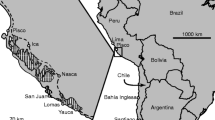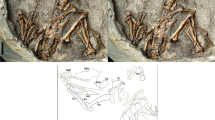Abstract
The anatomy of the skeletal elements of the hind limb of Thalassocnus is described. This genus of “ground sloth” comprises five species represented by Neogene specimens from the coast of Peru and Chile, mostly found in the Pisco Formation. The hind limb of the genus Thalassocnus as a whole is characterized by a small iliac wing, a gracile femur with well-formed femoral neck, teardrop shaped patella, long and slender tibia, triangular tuber calcis, and proximal development of the lateral process of the Mt V. The comparison of the species of Thalassocnus with each other suggests a progressive shift to a particular ecology from the earliest to the latest species of the genus, a conclusion in agreement with those of the studies of craniomandibular, dental, and forelimb gross morphology, and bone internal microstructure. The pedolateral stance, which involves the bearing of the weight on the lateral side of the foot, was practiced by the earliest species of Thalassocnus, as was the case for other Megatheria. This stance was apparently forsaken by the late species of the genus in favor of the acquisition of a secondary plantigrady. A plantigrade hind limb may have been more efficient for paddling and for bottom-walking. Additionally, the late species of Thalassocnus differ from the early ones in the morphology of the pelvis and the slight overall reduction of the hind limb. This suggests the decrease of the support function of the hind limb of these species when compared to that of the early species of Thalassocnus.

















































Similar content being viewed by others
References
Amson E, Muizon C de, Laurin M, Argot C, Buffrénil V de (2014) Gradual adaptation of bone structure to aquatic lifestyle in extinct sloths from Peru. Proc R Soc B 281:20140192. doi: 10.1098/rspb.2014.0192
Amson E, Argot C, McDonald HG, Muizon C de (in press) Osteology and functional morphology of the forelimb of the marine sloth Thalassocnus (Mammalia, Tardigrada). J Mammal Evol. doi:10.1007/s10914-014-9268-3
Barone R (1968) Anatomie Comparée des Mammifères Domestiques, Tome 2, Arthrologie et Myologie. Imprimerie des Beaux-Arts, Lyon
Blanco RE, Czerwonogora A (2003) The gait of Megatherium Cuvier 1796. Senckenb Biol 83:61–68
Cartelle C, Fonseca JS (1983) Contribuição ao melhor conhecimento da pequena preguiça terrícola Nothrotherium maquinense (Lund) Lydekker, 1889. Lundiana 2:127–181
Casinos A (1996) Bipedalism and quadrupedalism in Megatherium: an attempt at biomechanical reconstruction. Lethaia 29:1–112
De Iuliis G (1994) Relationships of the Megatheriinae, Nothrotheriinae, and Planopsinae: some skeletal characteristics and their importance for phylogeny. J Vertebr Paleontol 14:577–591
De Iuliis G, Gaudin TJ, Vicars MJ (2011) A new genus and species of nothrotheriid sloth (Xenarthra, Tardigrada, Nothrotheriidae) from the late Miocene (Huayquerian) of Peru. Palaeontology 54:171–205. doi: 10.1111/j.1475-4983.2010.01001.x
DeSilva JM, Holt KG, Churchill SE, Carlson KJ, Walker CS, Zipfel B, Berger LR (2013) The lower limb and mechanics of walking in Australopithecus sediba. Science 340:1232999. doi: 10.1126/science.1232999
Domning DP (2002) The terrestrial posture of desmostylians. Smithson Contrib Paleobiol 93:99–111.
Domning DP, Buffrénil V de (1991) Hydrostasis in the Sirenia: quantitative data and functional interpretations. Mar Mammal Sci 7:331–368
Ehret DJ, Macfadden BJ, Jones DS, DeVries TJ, Foster DA, Salas-Gismondi R (2012) Origin of the white shark Carcharodon (Lamniformes: Lamnidae) based on recalibration of the upper Neogene Pisco Formation of Peru. Palaeontology 55:1139–1153. doi: 10.1111/j.1475-4983.2012.01201.x
Gambaryan PP, Zherebtsova OV, Perepelova AA, Platonov VV (2009) Pes muscles and their action in giant anteater Myrmecophaga tridactyla (Myrmecophagidae, Pilosa) compared with other plantigrade mammals. Russ J Theriol 8:1–15
Gaudin TJ (2004) Phylogenetic relationships among sloths (Mammalia, Xenarthra, Tardigrada): the craniodental evidence. Zool J Linn Soc 140:255–305. doi: 10.1111/j.1096-3642.2003.00100.x
Hildebrand M (1985) Digging of quadrupeds. In: Hildebrand M (ed) Functional Vertebrate Morphology. Cambridge University Press, Cambridge, pp 89–109
Hirschfeld SE (1985) Ground sloths from the Friasian La Venta fauna, with additions to the pre-Friasian Coyaima fauna of Colombia, South America. Univ Calif Publ Geol Sci 128:1–91
Hoffstetter R (1961) Description d’un squelette de Planops (Gravigrade du Miocène de Patagonie). Mammalia 25:1–96
Hoffstetter R (1968) Un gisement de vertébrés tertiaires à Sacaco (Sud-Pérou), témoin néogène d’une migration de faunes australes au long de la côte occidentale sud-américaine. Comptes rendus hebdomadaires des séances l’Académie des Sciences Série D 267:1273–1276
Howell AB (1930) Aquatic Mammals: Their Adaptations to Life in the Water. Charles C Thomas, Springfield
Jenkins FA Jr, Camazine SM (1977) Hip structure and locomotion in ambulatory and cursorial carnivores. J Zool 181:351–370
Lessertisseur J, Saban R (1967) Squelette appendiculaire. In: Grassé P-P (ed) Traité de Zoologie, Tome 16. Masson et Cie, Paris, pp 709–1076
Lull RS (1929) A remarkable ground sloth. Mem Peabody Museum Yale Univ 3:1–39. doi: 10.1002/asna.19292372003
Matthew WD, Paula Couto C de (1959) The Cuban edentates. Bull Am Mus Nat Hist 117:1–56
McDonald HG (1977) Description of the osteology of the extinct gravigrade edentate Megalonyx with observations on its ontogeny, phylogeny, and functional anatomy. Dissertation, University of Florida, Gainseville
McDonald HG (2007) Biomechanical inferences of locomotion in ground sloths: integrating morphological and track data. Cenozoic Vertebrate Track and Traces. New Mexico Mus Nat Hist Sci Bull 42:201–208
McDonald HG (2012) Evolution of the pedolateral foot in ground sloths: patterns of change in the astragalus. J Mammal Evol 19:209–215. doi: 10.1007/s10914-011-9182-x
McDonald HG, Muizon C de (2002) The cranial anatomy of Thalassocnus (Xenarthra, Mammalia), a derived nothrothere from the Neogene of the Pisco Formation (Peru). J Vertebr Paleontol 22:349–365
Miller ME, Christensen G, Evans H (1965) Anatomy of the Dog. W.B. Saunders, Philadelphia
Milne N, Toledo N, Vizcaíno SF (2012) Allometric and group differences in the xenarthran femur. J Mammal Evol 19:199–208. doi: 10.1007/s10914-011-9171-0
Muizon C de, McDonald HG (1995) An aquatic sloth from the Pliocene of Peru. Nature 375:224–227. doi: 10.1038/375224a0
Muizon C de, McDonald HG, Salas R, Urbina M (2003) A new early species of the aquatic sloth Thalassocnus (Mammalia, Xenarthra) from the late Miocene of Peru. J Vertebr Paleontol 23:886–894. doi: 10.1671/2361-13
Muizon C de, McDonald HG, Salas R, Urbina M (2004a) The youngest species of the aquatic sloth Thalassocnus and a reassessment of the relationships of the nothrothere sloths (Mammalia: Xenarthra). J Vertebr Paleontol 24:287–397. doi: 10.1671/2429a
Muizon C de, McDonald HG, Salas R, Urbina M (2004b) The evolution of feeding adaptations of the aquatic sloth Thalassocnus. J Vertebr Paleontol 24:398–410. doi: 10.1671/2429b
Owen R (1842) Description of the skeleton of an extinct gigantic sloth, Mylodon robustus, Owen, with observations on the osteology, natural affinities, and probable habits of the megatherioid quadrupeds in general. R Coll Surg Engl London 1–176, 24 plates
Owen R (1858) On the Megatherium (Megatherium americanum, Cuvier and Blumenbach). Part IV. Bones of the anterior extremities. Phil Trans R Soc London 148:261–278
Owen R (1859) On the Megatherium (Megatherium americanum, Cuvier and Blumenbach). Part V. Bones of the posterior extremities. Phil Trans R Soc 149:809–829
Polly PD (2007) Limbs in mammalian evolution. In: Hall BK (ed) Fins into Limbs: Evolution, Development, and Transformation. University of Chicago Press, Chicago, pp 245–268
Pujos F, Salas R (2004) A new species of Megatherium (Mammalia: Xenarthra: Megatheriidae) from the Pleistocene of Sacaco and Tres Ventanas, Peru. Palaeontology 47:579–604. doi: 10.1111/j.0031-0239.2004.00376.x
Pujos F, De Iuliis G, Argot C, Werdelin L (2007) A peculiar climbing Megalonychidae from the Pleistocene of Peru and its implication for sloth history. Zool J Linn Soc 149:179–235
Pyenson ND, Gutstein CS, Parham JF, Little H, Metallo A, Roux P Le, Carren C, Rossi V, Valenzuela-Toro AM, Velez-Juarbe J, Santelli CM, Rogers DR, Cozzuol MA, Suárez ME (2014) Repeated mass strandings of Miocene marine mammals from Atacama Region of Chile point to sudden death at sea. Proc R Soc B 281:20133316. doi: 10.1098/rspb.2013.3316
Reinhardt J (1878) Kæmpedovendyr-Slægten Coelodon. Danske Vidensk Selsk Skr Naturvidenskabelig og Math Afd Ser 5 12:255–349
Salas R, Pujos F, Muizon C de (2005) Ossified meniscus and cyamo-fabella in some fossil sloths: a morpho-functional interpretation. Geobios 38:389–394. doi: 10.1016/j.geobios.2003.11.009
Scott WB (1903–1904) Mammalia of the Santa Cruz beds. Reports Princeton University Expedition to Patagonia 5:1–490. doi: 10.1525/mua.2006.29.2.153
Shefelbine SJ, Tardieu C, Carter DR (2002) Development of the femoral bicondylar angle in hominid bipedalism. Bone 30:765–770. doi: 10.1016/S8756-3282(02)00700-7
Stock C (1917) Structure of the pes in Mylodon harlani. Univ Calif Publ 10:267–286
Stock C (1925) Cenozoic gravigrade edentates of western North America, with special reference to the Pleistocene Megalonychinae and Mylodontidae of Rancho La Brea. Carnegie Inst Wash Publ 331:1–206
Thewissen JGM, Taylor MA (2007) Aquatic adaptations in the limbs of amniotes. In: Hall BK (ed) Fins into Limbs: Evolution, Development, and Transformation. University of Chicago Press, Chicago, pp 310–322
White JL (1993) Indicators of locomotor habits in xenarthrans: evidence for locomotor heterogeneity among fossil sloths. J Vertebr Paleontol 13:230–242
White JL (1997) Locomotor adaptations in Miocene xenarthrans. In: Kay RF, Madden RH, Cifelli RL, Flynn JJ (eds) Vertebrate Paleontology in the Neotropics—The Miocene Fauna of La Venta, Colombia. Smithsonian Institution Press, Washington, D.C., pp 246–264
Acknowledgments
We are indebted to Rodolfo Salas-Gismondi (MUSM), Samuel McLeod and Vanessa Rhue (both LACM), Castor Cartelle (MCL), and Géraldine Veron (MNHN), who allowed access to the collections under their care. Rodolfo Salas-Gismondi (MUSM) and Mario Urbina (MUSM) are thanked for collecting numerous specimens of Thalassocnus. François Pujos (CCT-CONICET-Mendoza) and Rodolfo Salas-Gismondi (MUSM) are acknowledged for the assistance they provided regarding general xenarthran questions. Manuel Martínez-Cáceres is thanked for taking pictures of one specimen at the MUSM. We thank Colas Bouillet (MNHN), Batz Le Dimet (MNHN), Philippe Richir (MNHN), and Renaud Vacant (CNRS) for preparing and/or helping prepare some of the fossils included in this study. Christian Lemzaouda and Philippe Loubry (CNRS) are thanked for taking the photographs that illustrate this paper. Finally, we warmly thank the anonymous reviewer for his extremely thorough and meticulous work. His numerous suggestions and corrections conspicuously improved the manuscript.
Author information
Authors and Affiliations
Corresponding author
Electronic supplementary material
Below is the link to the electronic supplementary material.
Online Resource 1
Specimen numbers of Thalassocnus hind limb material. Abbreviations: (R), right; (L), left; (R&L), right and left; (R or L), right or left (unknown laterality). (XLSX 16 kb)
Rights and permissions
About this article
Cite this article
Amson, E., Argot, C., McDonald, H.G. et al. Osteology and Functional Morphology of the Hind Limb of the Marine Sloth Thalassocnus (Mammalia, Tardigrada). J Mammal Evol 22, 355–419 (2015). https://doi.org/10.1007/s10914-014-9274-5
Published:
Issue Date:
DOI: https://doi.org/10.1007/s10914-014-9274-5




